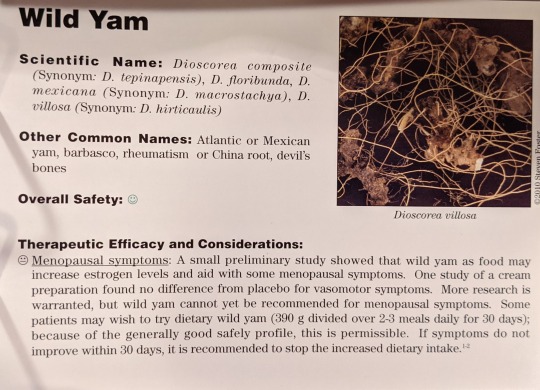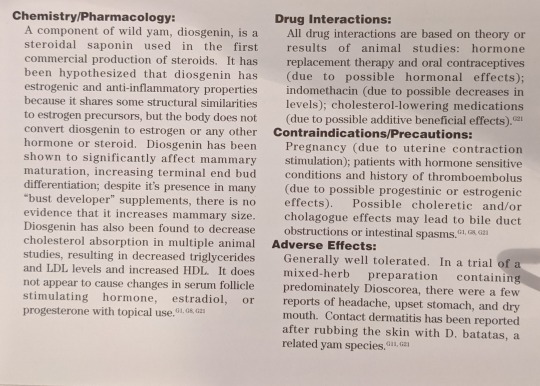#dioscorea floribunda
Text
Wild Yam


Scientific Names: Dioscorea composite (synonym: D. tepinapensis), D. floribunda, D. mexicana (synonym: D. macrostachya), D. villosa (synonym: D. hirticaulis)
Other Common Names: Atlantic or Mexican yam, barbasco, rheumatism, or China root, devil’s bones
Overall Safety: 😊
Therapeutic Efficacy and Considerations:
Menopausal Symptoms: 😐 A small preliminary study showed that wild yam as food may increase estrogen levels and aid with some menopausal symptoms. One study of a cream preparation found no difference from placebo for vasomotor symptoms. More research is warranted, but wild yam cannot yet be recommended for menopausal symptoms. Some patients may wish to try dietary wild yam (390 g divided over 2-3 meals daily for 30 days); because of the generally good safety profile, this is permissible. If symptoms do not improve within 30 days, it is recommended to stop the increased dietary intake.
Chemistry/Pharmacology:
A component of wild yam, diosgenin, is a steroidal saponin used in the first commercial production of steroids. It has been hypothesized that diosgenin has estrogenic and anti-inflammatory properties because it shares some structural similarities to estrogen precursors, but the body does not convert diosgenin to estrogen or any other hormone or steroid. Diosgenin has been shown to significantly affect mammary maturation, increasing terminal end bud differentiation; despite its presence in many “bust developer” supplements, there is no evidence that it increases mammary size. Diosgenin has also been found to decrease cholesterol absorption in multiple animal studies, resulting in decreased triglycerides and LDL levels and increased HDL. It does not appear to cause changes in serum follicle stimulating hormone, estradiol, or progesterone with topical use.
Drug Interactions:
All drug interactions are based on theory or results of animal studies: hormone replacement therapy and oral contraceptives (due to possible hormonal effects); indomethacin (due to possible decreases in levels); cholesterol-lowering medications (due to possible additive beneficial effects).
Contraindications/Precautions:
Pregnancy (due to uterine contraction stimulation); patients with hormone-sensitive conditions and history of thromboembolism (due to possible progestinic or estrogenic effects). Possible choleretic and/or cholagogue effects may lead to bile duct obstructions or intestinal spasms.
Adverse Effects:
Generally, well tolerated. In a trial of a mixed-herb preparation containing predominantly Dioscorea, there were a few reports of headache, upset stomach, and dry mouth. Contact dermatitis has been reported after rubbing the skin with D. batatas, a related yam species.
#sigler dietary supplement drug cards#2nd edition#wild yam#dioscorea composite#dioscorea tepinapensis#dioscorea floribunda#dioscorea macrostachya#dioscorea villosa#dioscorea hirticaulis#drug facts#atlantic yam#mexican yam#barbasco#rheumatism#china root#devil's bones
0 notes
Text
Wild Yam For male enhancement
However, wild yam root contains other active compounds that are responsible for its effects, such as beta carotene and phytosterols. Also known as colic root and rheumatism root, wild yam has a long history of use by women for various gynecological complaints. In ovariectomized mice, 20-40mg/kg of the wild yam constituent diosgenin, injected subcutaneously each day for 15 days, was found to stimulate mammary gland epithelial growth without observed progestinic effects.
Because of the growing trend of applying medications cutaneously and our beliefs about absorbing nutrients through the skin, we decided to put wild yam root into a cream. This product contains the whole wild yam root and all its bio-constituents plus wild yam root extract made with sugarcane alcohol. Wild Yam can have beneficial effects on menopausal symptoms of the skin, especially those that affect the skin, such as reddening, flashing, thinning skin, brown spots, and exceptionally dry skin, especially vaginal dryness.
Contains the herbs Wild Yam (Dioscorea villosa) and Marigold (Calendula officinalis). In Traditional Chinese Medicine, wild yam root is used as a Saw palmetto male enhancement ingredient (maleenhancementcomplex.com) traditional women's herb. It is used for herbal preparations and body care products.
In addition, Mexican yam and wild yam products are said to boost progesterone effects that fall during the last half of the month. The wild yam (Dioscorea villosa ) is a climbing plant that is native to the southeast United States and Canada Such wild yam species as Dioscorea floribunda as well as Dioscorea villosa are native to Mexico. A compound in wild yam, called diosgenin, is used as the basis for synthesizing several steroids, including progesterone and estrogen.
Though DHEA has been sythnesized from wild yam extract in the lab, it's not clear if the human body can convert diosgenin into estrogen. It is not clear whether Dioscorea villosa (wild yam) lowers blood sugar levels. Wild yam was believed in the past to have properties similar to the reproductive hormone progesterone, but this has not been supported by scientific studies.
Rubbing the skin with Dioscorea batatas (a yam species related to Dioscorea villosa) has been reported to cause allergic rash. Specially formulated to support women experiencing menopause, Piping Rock's soothing Wild Yam Cream is a must-have when Mother Nature steps in. Experience the soothing comfort and lend yourself to age-old skin nourishment as you gently massage the cream into your underarms, breasts, lower back and tummy... and continue to live your life happily and comfortably during those monthly and midlife changes! There may be a value to taking progesterone in cream form, but the wild yam part of the product seems to be misleading.
An interesting point is that some wild yam products do contain progesterone. Studies involving cells in a test tube have found that wild yam does not act like estrogen or progesterone. Thus, any product that claims to contain "natural progesterone from wild yam" is misleading.
However, just because chemists can make progesterone out of diosgenin does not mean that the body can do the same.
0 notes
Text
Diosgenin saponins from Dioscorea floribunda
http://dlvr.it/Nh0ZZw
0 notes